Modular Construction: Sustainable High-Rise Building Analysis Report
VerifiedAdded on 2023/06/07
|19
|5588
|72
Report
AI Summary
This report delves into the realm of modular construction as a sustainable approach for high-rise buildings, examining its impact on waste reduction, cost-effectiveness, and environmental benefits. The analysis encompasses case studies of the T30 Hotel in China, Paragon in London, and the 32 Storeys in New York, evaluating the image, economic, technological, engineering, and architectural factors. The report highlights the advantages of prefabricated structures, such as environmental protection, industrial production, and rapid construction, particularly in comparison to traditional methods. The discussion section assesses the design considerations, structural systems, and material choices involved in modular high-rise construction, emphasizing the importance of early integration of modular design. The report also identifies limitations, such as potential constraints on design flexibility and fire resistance, while also highlighting the significant advancements in sustainable building practices. The study underscores the potential of modular construction to improve construction efficiency, reduce waste, and promote sustainability in the building industry.
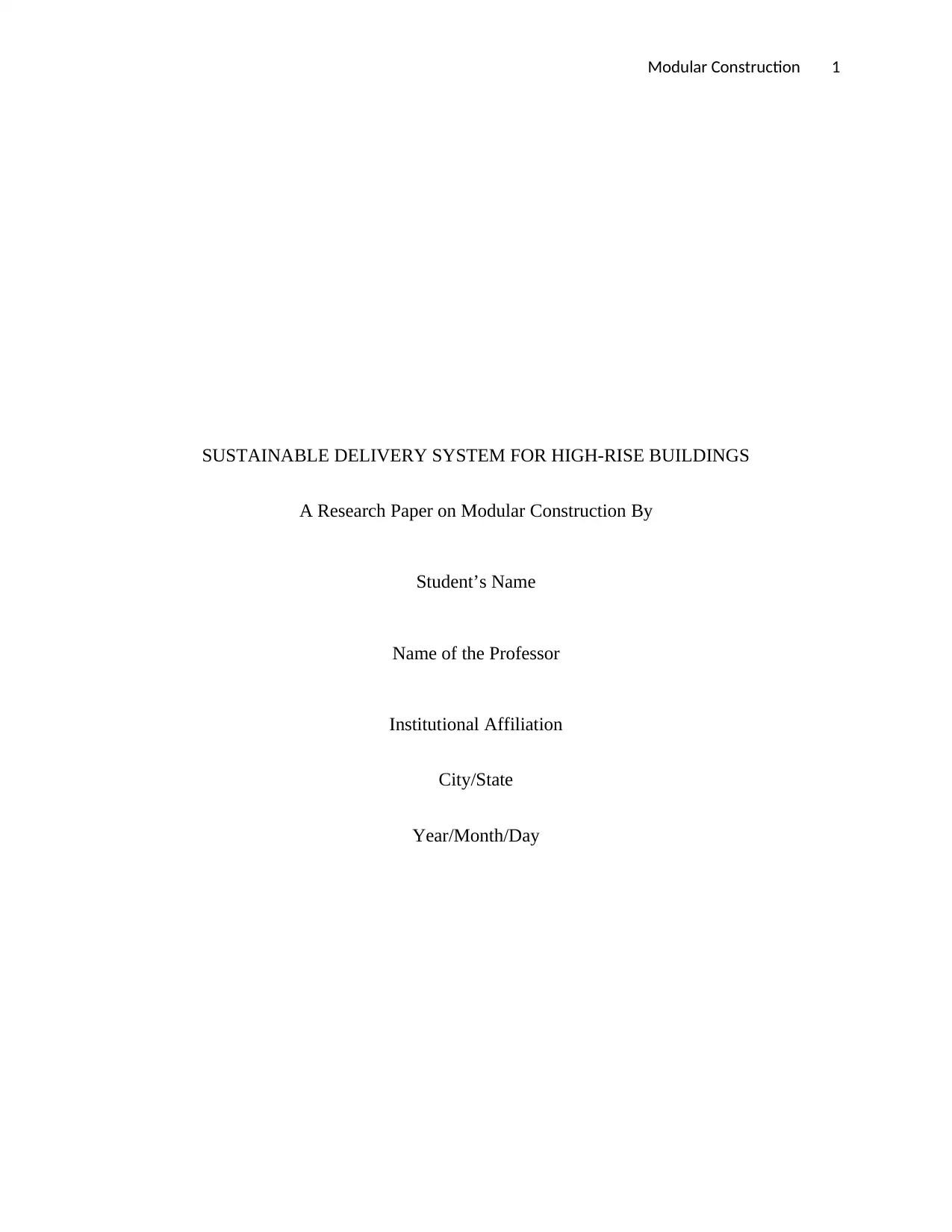
Modular Construction 1
SUSTAINABLE DELIVERY SYSTEM FOR HIGH-RISE BUILDINGS
A Research Paper on Modular Construction By
Student’s Name
Name of the Professor
Institutional Affiliation
City/State
Year/Month/Day
SUSTAINABLE DELIVERY SYSTEM FOR HIGH-RISE BUILDINGS
A Research Paper on Modular Construction By
Student’s Name
Name of the Professor
Institutional Affiliation
City/State
Year/Month/Day
Paraphrase This Document
Need a fresh take? Get an instant paraphrase of this document with our AI Paraphraser
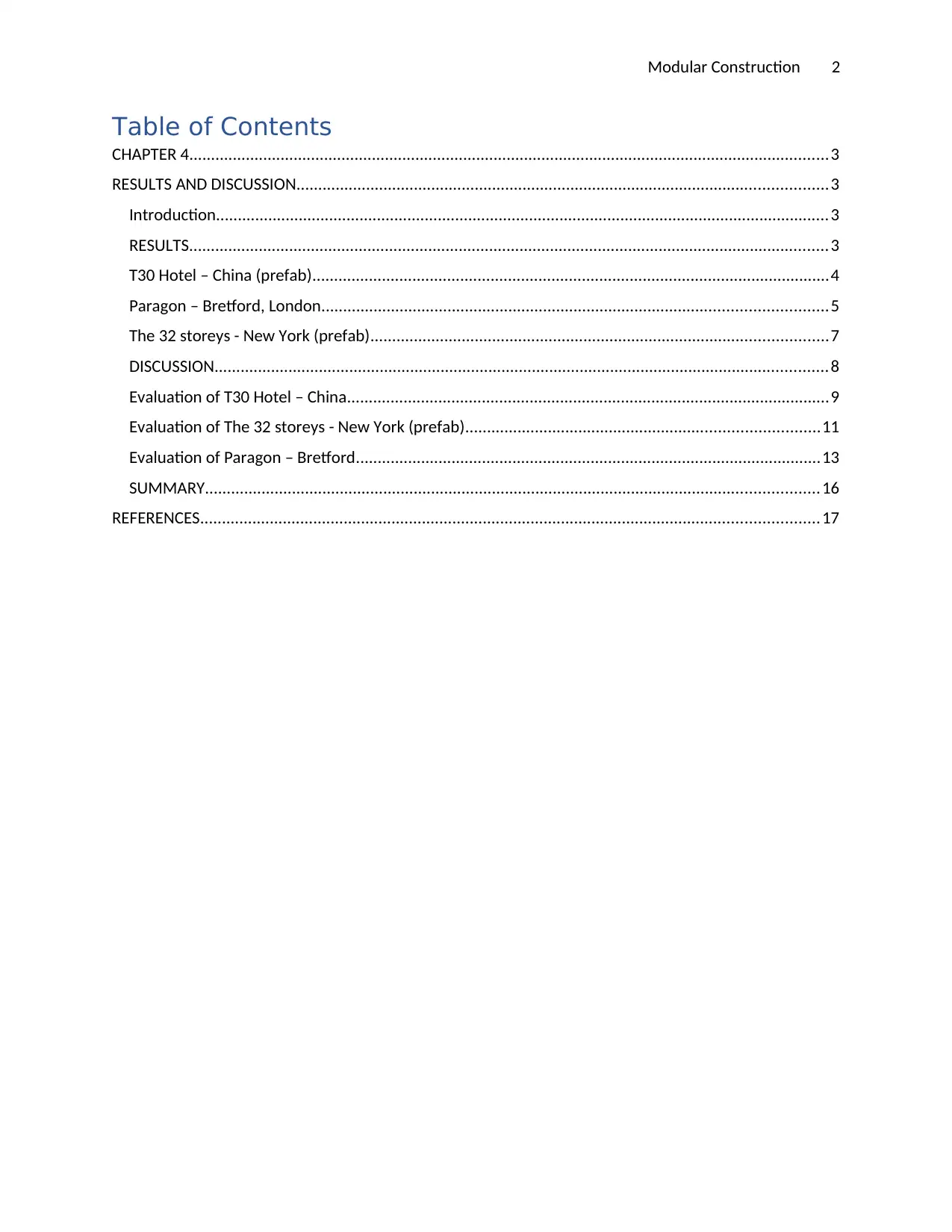
Modular Construction 2
Table of Contents
CHAPTER 4...................................................................................................................................................3
RESULTS AND DISCUSSION..........................................................................................................................3
Introduction.............................................................................................................................................3
RESULTS...................................................................................................................................................3
T30 Hotel – China (prefab).......................................................................................................................4
Paragon – Bretford, London....................................................................................................................5
The 32 storeys - New York (prefab).........................................................................................................7
DISCUSSION.............................................................................................................................................8
Evaluation of T30 Hotel – China...............................................................................................................9
Evaluation of The 32 storeys - New York (prefab).................................................................................11
Evaluation of Paragon – Bretford...........................................................................................................13
SUMMARY.............................................................................................................................................16
REFERENCES..............................................................................................................................................17
Table of Contents
CHAPTER 4...................................................................................................................................................3
RESULTS AND DISCUSSION..........................................................................................................................3
Introduction.............................................................................................................................................3
RESULTS...................................................................................................................................................3
T30 Hotel – China (prefab).......................................................................................................................4
Paragon – Bretford, London....................................................................................................................5
The 32 storeys - New York (prefab).........................................................................................................7
DISCUSSION.............................................................................................................................................8
Evaluation of T30 Hotel – China...............................................................................................................9
Evaluation of The 32 storeys - New York (prefab).................................................................................11
Evaluation of Paragon – Bretford...........................................................................................................13
SUMMARY.............................................................................................................................................16
REFERENCES..............................................................................................................................................17
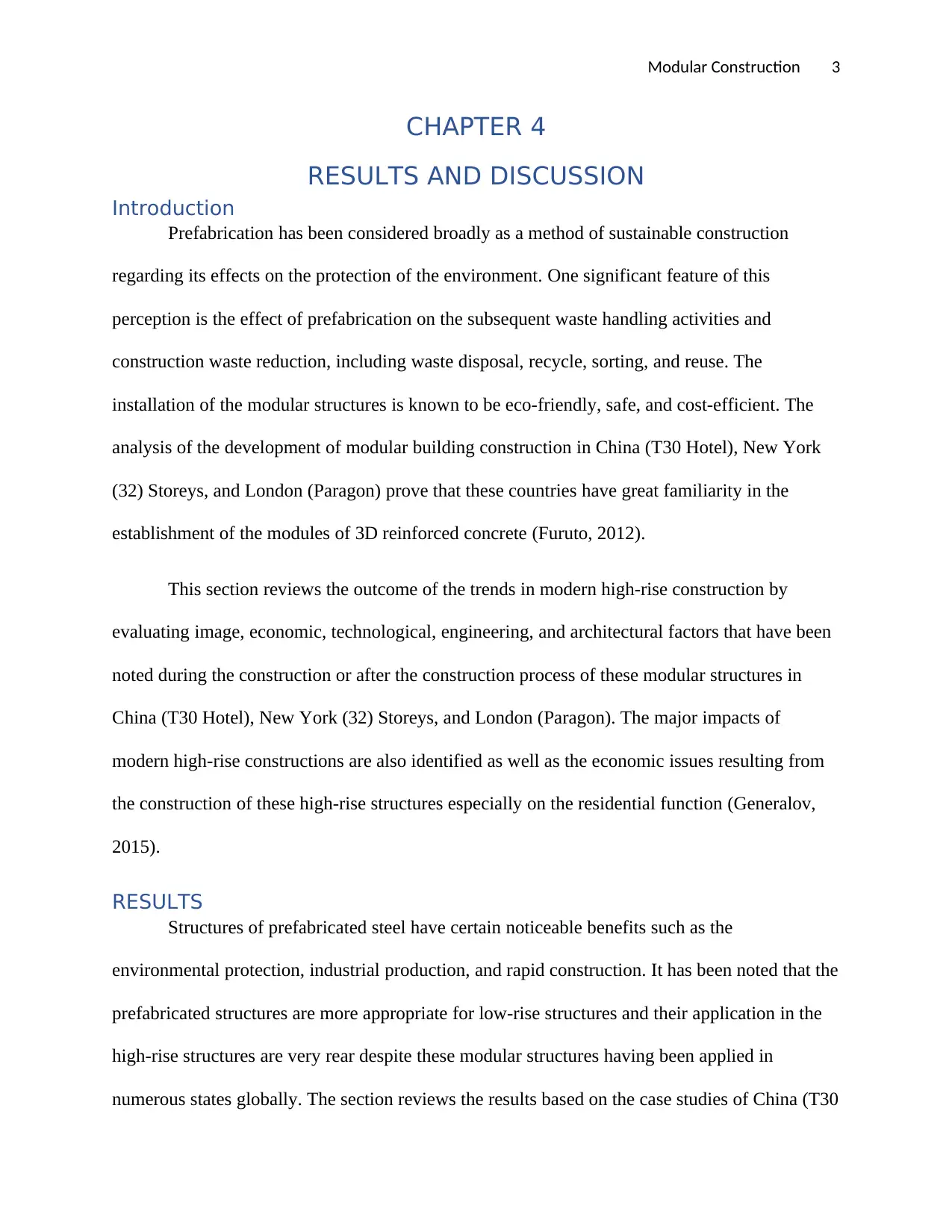
Modular Construction 3
CHAPTER 4
RESULTS AND DISCUSSION
Introduction
Prefabrication has been considered broadly as a method of sustainable construction
regarding its effects on the protection of the environment. One significant feature of this
perception is the effect of prefabrication on the subsequent waste handling activities and
construction waste reduction, including waste disposal, recycle, sorting, and reuse. The
installation of the modular structures is known to be eco-friendly, safe, and cost-efficient. The
analysis of the development of modular building construction in China (T30 Hotel), New York
(32) Storeys, and London (Paragon) prove that these countries have great familiarity in the
establishment of the modules of 3D reinforced concrete (Furuto, 2012).
This section reviews the outcome of the trends in modern high-rise construction by
evaluating image, economic, technological, engineering, and architectural factors that have been
noted during the construction or after the construction process of these modular structures in
China (T30 Hotel), New York (32) Storeys, and London (Paragon). The major impacts of
modern high-rise constructions are also identified as well as the economic issues resulting from
the construction of these high-rise structures especially on the residential function (Generalov,
2015).
RESULTS
Structures of prefabricated steel have certain noticeable benefits such as the
environmental protection, industrial production, and rapid construction. It has been noted that the
prefabricated structures are more appropriate for low-rise structures and their application in the
high-rise structures are very rear despite these modular structures having been applied in
numerous states globally. The section reviews the results based on the case studies of China (T30
CHAPTER 4
RESULTS AND DISCUSSION
Introduction
Prefabrication has been considered broadly as a method of sustainable construction
regarding its effects on the protection of the environment. One significant feature of this
perception is the effect of prefabrication on the subsequent waste handling activities and
construction waste reduction, including waste disposal, recycle, sorting, and reuse. The
installation of the modular structures is known to be eco-friendly, safe, and cost-efficient. The
analysis of the development of modular building construction in China (T30 Hotel), New York
(32) Storeys, and London (Paragon) prove that these countries have great familiarity in the
establishment of the modules of 3D reinforced concrete (Furuto, 2012).
This section reviews the outcome of the trends in modern high-rise construction by
evaluating image, economic, technological, engineering, and architectural factors that have been
noted during the construction or after the construction process of these modular structures in
China (T30 Hotel), New York (32) Storeys, and London (Paragon). The major impacts of
modern high-rise constructions are also identified as well as the economic issues resulting from
the construction of these high-rise structures especially on the residential function (Generalov,
2015).
RESULTS
Structures of prefabricated steel have certain noticeable benefits such as the
environmental protection, industrial production, and rapid construction. It has been noted that the
prefabricated structures are more appropriate for low-rise structures and their application in the
high-rise structures are very rear despite these modular structures having been applied in
numerous states globally. The section reviews the results based on the case studies of China (T30
⊘ This is a preview!⊘
Do you want full access?
Subscribe today to unlock all pages.

Trusted by 1+ million students worldwide
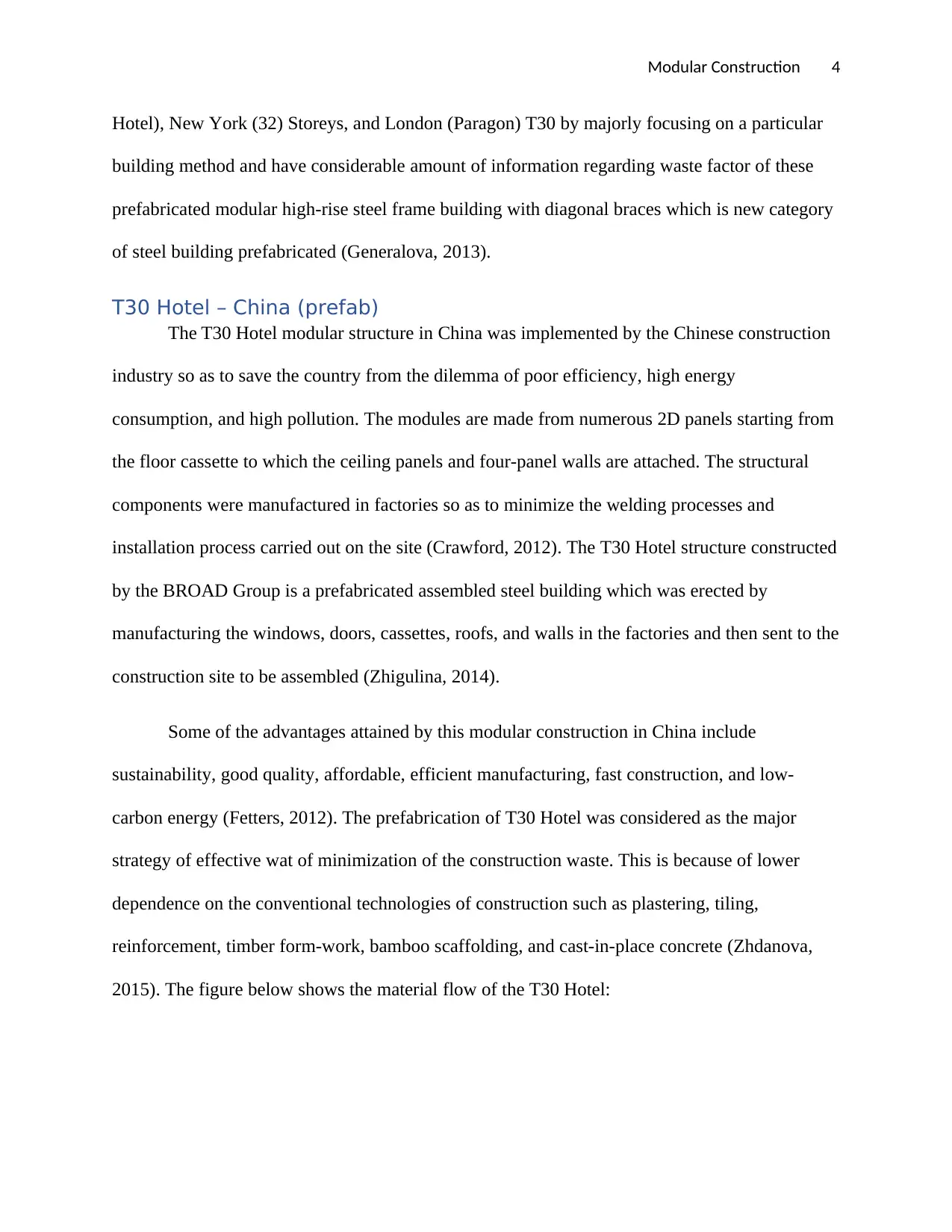
Modular Construction 4
Hotel), New York (32) Storeys, and London (Paragon) T30 by majorly focusing on a particular
building method and have considerable amount of information regarding waste factor of these
prefabricated modular high-rise steel frame building with diagonal braces which is new category
of steel building prefabricated (Generalova, 2013).
T30 Hotel – China (prefab)
The T30 Hotel modular structure in China was implemented by the Chinese construction
industry so as to save the country from the dilemma of poor efficiency, high energy
consumption, and high pollution. The modules are made from numerous 2D panels starting from
the floor cassette to which the ceiling panels and four-panel walls are attached. The structural
components were manufactured in factories so as to minimize the welding processes and
installation process carried out on the site (Crawford, 2012). The T30 Hotel structure constructed
by the BROAD Group is a prefabricated assembled steel building which was erected by
manufacturing the windows, doors, cassettes, roofs, and walls in the factories and then sent to the
construction site to be assembled (Zhigulina, 2014).
Some of the advantages attained by this modular construction in China include
sustainability, good quality, affordable, efficient manufacturing, fast construction, and low-
carbon energy (Fetters, 2012). The prefabrication of T30 Hotel was considered as the major
strategy of effective wat of minimization of the construction waste. This is because of lower
dependence on the conventional technologies of construction such as plastering, tiling,
reinforcement, timber form-work, bamboo scaffolding, and cast-in-place concrete (Zhdanova,
2015). The figure below shows the material flow of the T30 Hotel:
Hotel), New York (32) Storeys, and London (Paragon) T30 by majorly focusing on a particular
building method and have considerable amount of information regarding waste factor of these
prefabricated modular high-rise steel frame building with diagonal braces which is new category
of steel building prefabricated (Generalova, 2013).
T30 Hotel – China (prefab)
The T30 Hotel modular structure in China was implemented by the Chinese construction
industry so as to save the country from the dilemma of poor efficiency, high energy
consumption, and high pollution. The modules are made from numerous 2D panels starting from
the floor cassette to which the ceiling panels and four-panel walls are attached. The structural
components were manufactured in factories so as to minimize the welding processes and
installation process carried out on the site (Crawford, 2012). The T30 Hotel structure constructed
by the BROAD Group is a prefabricated assembled steel building which was erected by
manufacturing the windows, doors, cassettes, roofs, and walls in the factories and then sent to the
construction site to be assembled (Zhigulina, 2014).
Some of the advantages attained by this modular construction in China include
sustainability, good quality, affordable, efficient manufacturing, fast construction, and low-
carbon energy (Fetters, 2012). The prefabrication of T30 Hotel was considered as the major
strategy of effective wat of minimization of the construction waste. This is because of lower
dependence on the conventional technologies of construction such as plastering, tiling,
reinforcement, timber form-work, bamboo scaffolding, and cast-in-place concrete (Zhdanova,
2015). The figure below shows the material flow of the T30 Hotel:
Paraphrase This Document
Need a fresh take? Get an instant paraphrase of this document with our AI Paraphraser
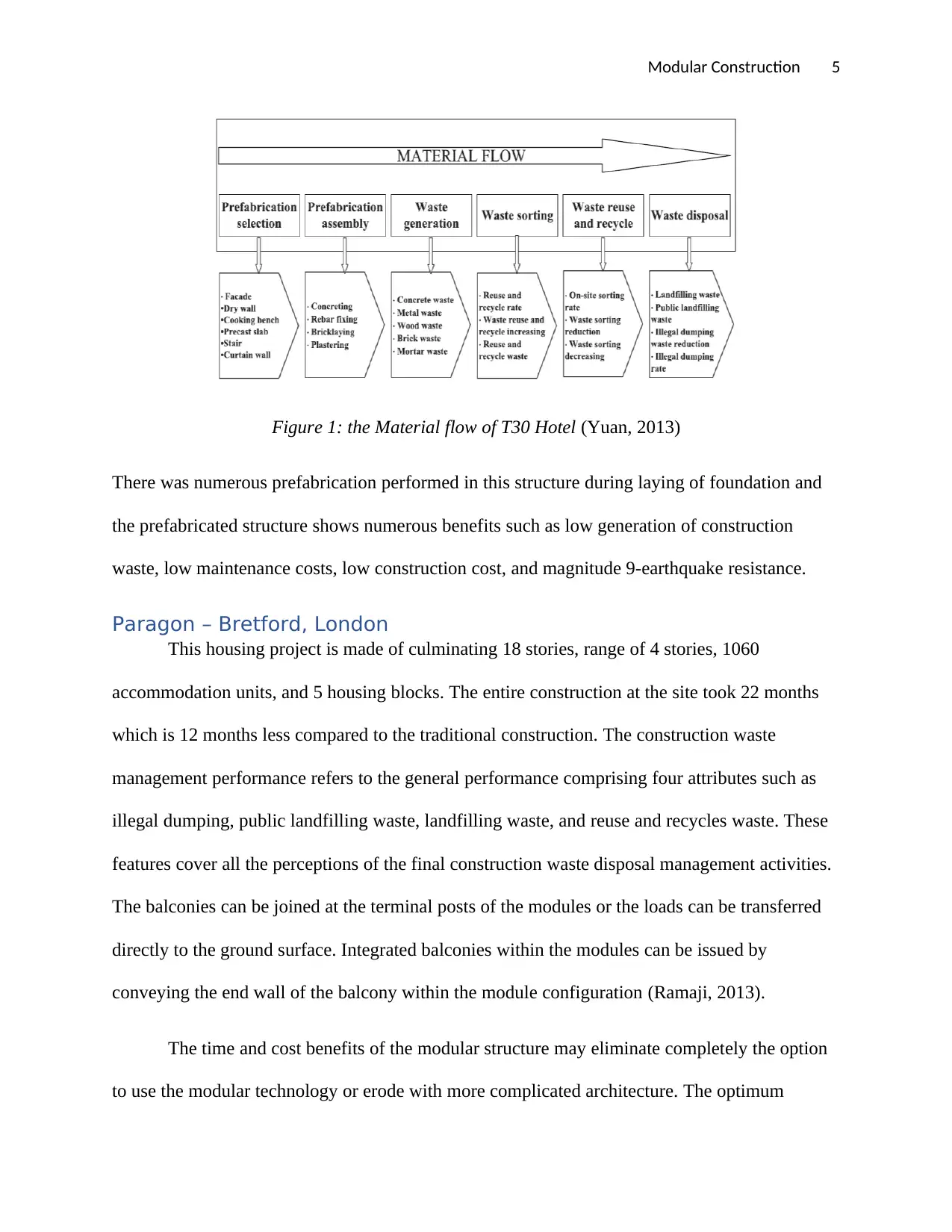
Modular Construction 5
Figure 1: the Material flow of T30 Hotel (Yuan, 2013)
There was numerous prefabrication performed in this structure during laying of foundation and
the prefabricated structure shows numerous benefits such as low generation of construction
waste, low maintenance costs, low construction cost, and magnitude 9-earthquake resistance.
Paragon – Bretford, London
This housing project is made of culminating 18 stories, range of 4 stories, 1060
accommodation units, and 5 housing blocks. The entire construction at the site took 22 months
which is 12 months less compared to the traditional construction. The construction waste
management performance refers to the general performance comprising four attributes such as
illegal dumping, public landfilling waste, landfilling waste, and reuse and recycles waste. These
features cover all the perceptions of the final construction waste disposal management activities.
The balconies can be joined at the terminal posts of the modules or the loads can be transferred
directly to the ground surface. Integrated balconies within the modules can be issued by
conveying the end wall of the balcony within the module configuration (Ramaji, 2013).
The time and cost benefits of the modular structure may eliminate completely the option
to use the modular technology or erode with more complicated architecture. The optimum
Figure 1: the Material flow of T30 Hotel (Yuan, 2013)
There was numerous prefabrication performed in this structure during laying of foundation and
the prefabricated structure shows numerous benefits such as low generation of construction
waste, low maintenance costs, low construction cost, and magnitude 9-earthquake resistance.
Paragon – Bretford, London
This housing project is made of culminating 18 stories, range of 4 stories, 1060
accommodation units, and 5 housing blocks. The entire construction at the site took 22 months
which is 12 months less compared to the traditional construction. The construction waste
management performance refers to the general performance comprising four attributes such as
illegal dumping, public landfilling waste, landfilling waste, and reuse and recycles waste. These
features cover all the perceptions of the final construction waste disposal management activities.
The balconies can be joined at the terminal posts of the modules or the loads can be transferred
directly to the ground surface. Integrated balconies within the modules can be issued by
conveying the end wall of the balcony within the module configuration (Ramaji, 2013).
The time and cost benefits of the modular structure may eliminate completely the option
to use the modular technology or erode with more complicated architecture. The optimum
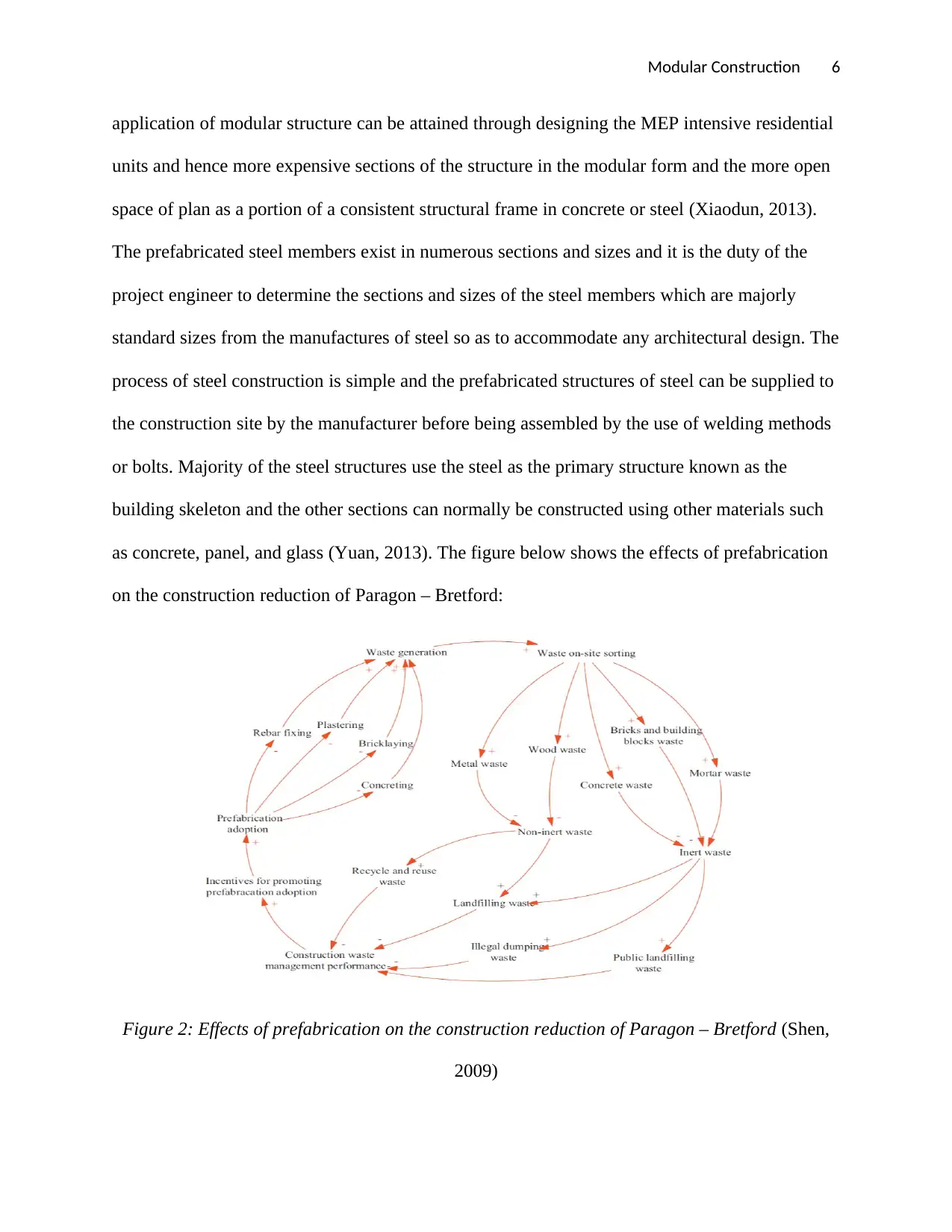
Modular Construction 6
application of modular structure can be attained through designing the MEP intensive residential
units and hence more expensive sections of the structure in the modular form and the more open
space of plan as a portion of a consistent structural frame in concrete or steel (Xiaodun, 2013).
The prefabricated steel members exist in numerous sections and sizes and it is the duty of the
project engineer to determine the sections and sizes of the steel members which are majorly
standard sizes from the manufactures of steel so as to accommodate any architectural design. The
process of steel construction is simple and the prefabricated structures of steel can be supplied to
the construction site by the manufacturer before being assembled by the use of welding methods
or bolts. Majority of the steel structures use the steel as the primary structure known as the
building skeleton and the other sections can normally be constructed using other materials such
as concrete, panel, and glass (Yuan, 2013). The figure below shows the effects of prefabrication
on the construction reduction of Paragon – Bretford:
Figure 2: Effects of prefabrication on the construction reduction of Paragon – Bretford (Shen,
2009)
application of modular structure can be attained through designing the MEP intensive residential
units and hence more expensive sections of the structure in the modular form and the more open
space of plan as a portion of a consistent structural frame in concrete or steel (Xiaodun, 2013).
The prefabricated steel members exist in numerous sections and sizes and it is the duty of the
project engineer to determine the sections and sizes of the steel members which are majorly
standard sizes from the manufactures of steel so as to accommodate any architectural design. The
process of steel construction is simple and the prefabricated structures of steel can be supplied to
the construction site by the manufacturer before being assembled by the use of welding methods
or bolts. Majority of the steel structures use the steel as the primary structure known as the
building skeleton and the other sections can normally be constructed using other materials such
as concrete, panel, and glass (Yuan, 2013). The figure below shows the effects of prefabrication
on the construction reduction of Paragon – Bretford:
Figure 2: Effects of prefabrication on the construction reduction of Paragon – Bretford (Shen,
2009)
⊘ This is a preview!⊘
Do you want full access?
Subscribe today to unlock all pages.

Trusted by 1+ million students worldwide
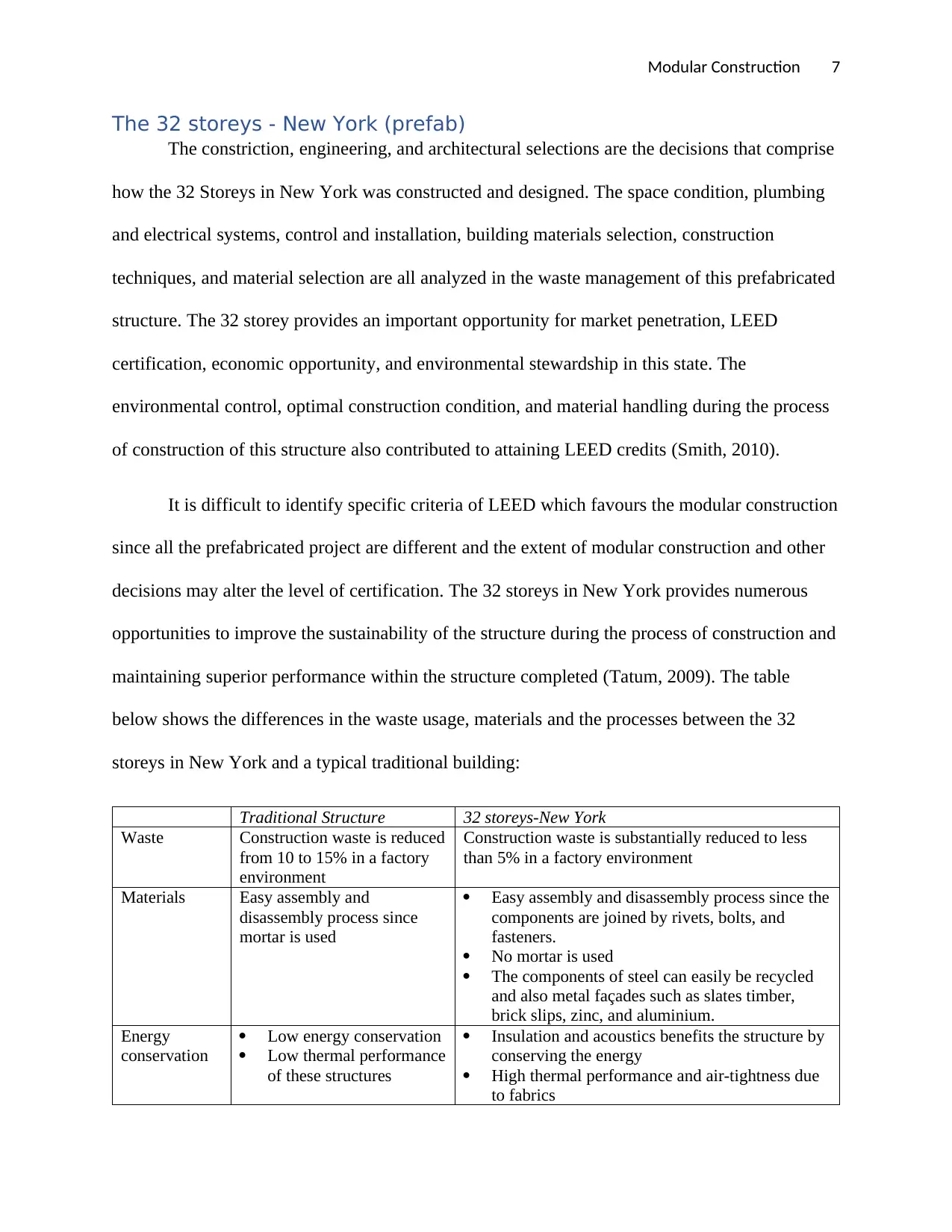
Modular Construction 7
The 32 storeys - New York (prefab)
The constriction, engineering, and architectural selections are the decisions that comprise
how the 32 Storeys in New York was constructed and designed. The space condition, plumbing
and electrical systems, control and installation, building materials selection, construction
techniques, and material selection are all analyzed in the waste management of this prefabricated
structure. The 32 storey provides an important opportunity for market penetration, LEED
certification, economic opportunity, and environmental stewardship in this state. The
environmental control, optimal construction condition, and material handling during the process
of construction of this structure also contributed to attaining LEED credits (Smith, 2010).
It is difficult to identify specific criteria of LEED which favours the modular construction
since all the prefabricated project are different and the extent of modular construction and other
decisions may alter the level of certification. The 32 storeys in New York provides numerous
opportunities to improve the sustainability of the structure during the process of construction and
maintaining superior performance within the structure completed (Tatum, 2009). The table
below shows the differences in the waste usage, materials and the processes between the 32
storeys in New York and a typical traditional building:
Traditional Structure 32 storeys-New York
Waste Construction waste is reduced
from 10 to 15% in a factory
environment
Construction waste is substantially reduced to less
than 5% in a factory environment
Materials Easy assembly and
disassembly process since
mortar is used
Easy assembly and disassembly process since the
components are joined by rivets, bolts, and
fasteners.
No mortar is used
The components of steel can easily be recycled
and also metal façades such as slates timber,
brick slips, zinc, and aluminium.
Energy
conservation
Low energy conservation
Low thermal performance
of these structures
Insulation and acoustics benefits the structure by
conserving the energy
High thermal performance and air-tightness due
to fabrics
The 32 storeys - New York (prefab)
The constriction, engineering, and architectural selections are the decisions that comprise
how the 32 Storeys in New York was constructed and designed. The space condition, plumbing
and electrical systems, control and installation, building materials selection, construction
techniques, and material selection are all analyzed in the waste management of this prefabricated
structure. The 32 storey provides an important opportunity for market penetration, LEED
certification, economic opportunity, and environmental stewardship in this state. The
environmental control, optimal construction condition, and material handling during the process
of construction of this structure also contributed to attaining LEED credits (Smith, 2010).
It is difficult to identify specific criteria of LEED which favours the modular construction
since all the prefabricated project are different and the extent of modular construction and other
decisions may alter the level of certification. The 32 storeys in New York provides numerous
opportunities to improve the sustainability of the structure during the process of construction and
maintaining superior performance within the structure completed (Tatum, 2009). The table
below shows the differences in the waste usage, materials and the processes between the 32
storeys in New York and a typical traditional building:
Traditional Structure 32 storeys-New York
Waste Construction waste is reduced
from 10 to 15% in a factory
environment
Construction waste is substantially reduced to less
than 5% in a factory environment
Materials Easy assembly and
disassembly process since
mortar is used
Easy assembly and disassembly process since the
components are joined by rivets, bolts, and
fasteners.
No mortar is used
The components of steel can easily be recycled
and also metal façades such as slates timber,
brick slips, zinc, and aluminium.
Energy
conservation
Low energy conservation
Low thermal performance
of these structures
Insulation and acoustics benefits the structure by
conserving the energy
High thermal performance and air-tightness due
to fabrics
Paraphrase This Document
Need a fresh take? Get an instant paraphrase of this document with our AI Paraphraser
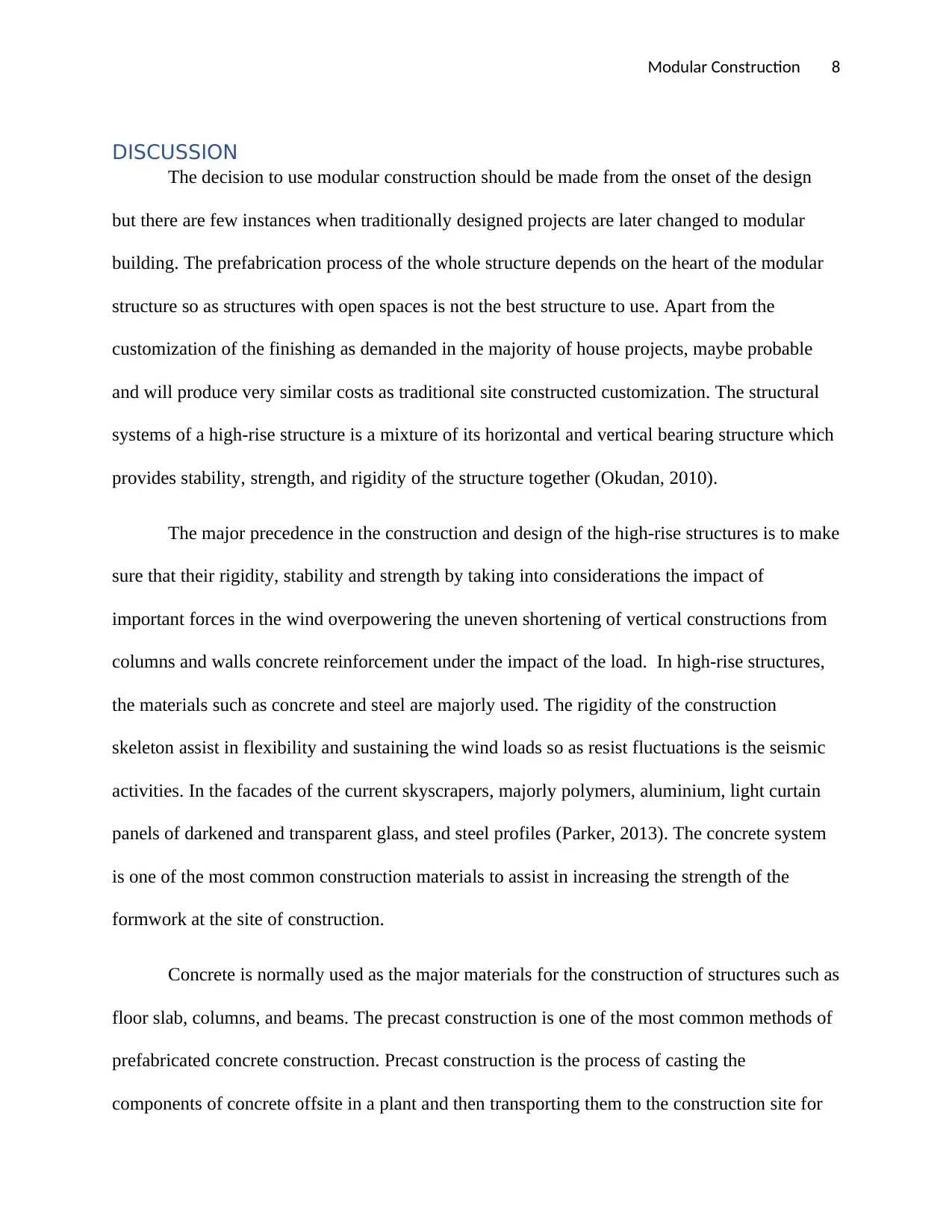
Modular Construction 8
DISCUSSION
The decision to use modular construction should be made from the onset of the design
but there are few instances when traditionally designed projects are later changed to modular
building. The prefabrication process of the whole structure depends on the heart of the modular
structure so as structures with open spaces is not the best structure to use. Apart from the
customization of the finishing as demanded in the majority of house projects, maybe probable
and will produce very similar costs as traditional site constructed customization. The structural
systems of a high-rise structure is a mixture of its horizontal and vertical bearing structure which
provides stability, strength, and rigidity of the structure together (Okudan, 2010).
The major precedence in the construction and design of the high-rise structures is to make
sure that their rigidity, stability and strength by taking into considerations the impact of
important forces in the wind overpowering the uneven shortening of vertical constructions from
columns and walls concrete reinforcement under the impact of the load. In high-rise structures,
the materials such as concrete and steel are majorly used. The rigidity of the construction
skeleton assist in flexibility and sustaining the wind loads so as resist fluctuations is the seismic
activities. In the facades of the current skyscrapers, majorly polymers, aluminium, light curtain
panels of darkened and transparent glass, and steel profiles (Parker, 2013). The concrete system
is one of the most common construction materials to assist in increasing the strength of the
formwork at the site of construction.
Concrete is normally used as the major materials for the construction of structures such as
floor slab, columns, and beams. The precast construction is one of the most common methods of
prefabricated concrete construction. Precast construction is the process of casting the
components of concrete offsite in a plant and then transporting them to the construction site for
DISCUSSION
The decision to use modular construction should be made from the onset of the design
but there are few instances when traditionally designed projects are later changed to modular
building. The prefabrication process of the whole structure depends on the heart of the modular
structure so as structures with open spaces is not the best structure to use. Apart from the
customization of the finishing as demanded in the majority of house projects, maybe probable
and will produce very similar costs as traditional site constructed customization. The structural
systems of a high-rise structure is a mixture of its horizontal and vertical bearing structure which
provides stability, strength, and rigidity of the structure together (Okudan, 2010).
The major precedence in the construction and design of the high-rise structures is to make
sure that their rigidity, stability and strength by taking into considerations the impact of
important forces in the wind overpowering the uneven shortening of vertical constructions from
columns and walls concrete reinforcement under the impact of the load. In high-rise structures,
the materials such as concrete and steel are majorly used. The rigidity of the construction
skeleton assist in flexibility and sustaining the wind loads so as resist fluctuations is the seismic
activities. In the facades of the current skyscrapers, majorly polymers, aluminium, light curtain
panels of darkened and transparent glass, and steel profiles (Parker, 2013). The concrete system
is one of the most common construction materials to assist in increasing the strength of the
formwork at the site of construction.
Concrete is normally used as the major materials for the construction of structures such as
floor slab, columns, and beams. The precast construction is one of the most common methods of
prefabricated concrete construction. Precast construction is the process of casting the
components of concrete offsite in a plant and then transporting them to the construction site for
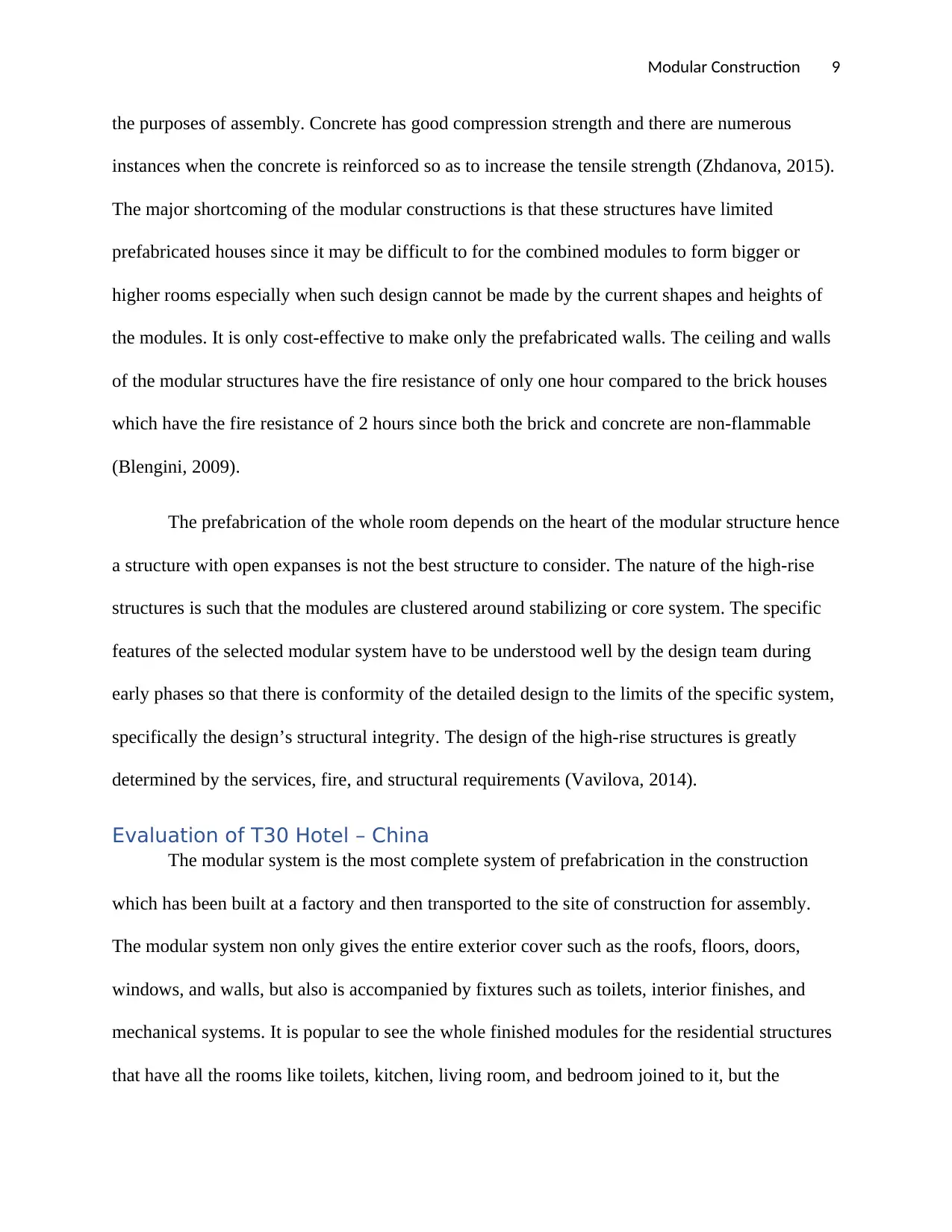
Modular Construction 9
the purposes of assembly. Concrete has good compression strength and there are numerous
instances when the concrete is reinforced so as to increase the tensile strength (Zhdanova, 2015).
The major shortcoming of the modular constructions is that these structures have limited
prefabricated houses since it may be difficult to for the combined modules to form bigger or
higher rooms especially when such design cannot be made by the current shapes and heights of
the modules. It is only cost-effective to make only the prefabricated walls. The ceiling and walls
of the modular structures have the fire resistance of only one hour compared to the brick houses
which have the fire resistance of 2 hours since both the brick and concrete are non-flammable
(Blengini, 2009).
The prefabrication of the whole room depends on the heart of the modular structure hence
a structure with open expanses is not the best structure to consider. The nature of the high-rise
structures is such that the modules are clustered around stabilizing or core system. The specific
features of the selected modular system have to be understood well by the design team during
early phases so that there is conformity of the detailed design to the limits of the specific system,
specifically the design’s structural integrity. The design of the high-rise structures is greatly
determined by the services, fire, and structural requirements (Vavilova, 2014).
Evaluation of T30 Hotel – China
The modular system is the most complete system of prefabrication in the construction
which has been built at a factory and then transported to the site of construction for assembly.
The modular system non only gives the entire exterior cover such as the roofs, floors, doors,
windows, and walls, but also is accompanied by fixtures such as toilets, interior finishes, and
mechanical systems. It is popular to see the whole finished modules for the residential structures
that have all the rooms like toilets, kitchen, living room, and bedroom joined to it, but the
the purposes of assembly. Concrete has good compression strength and there are numerous
instances when the concrete is reinforced so as to increase the tensile strength (Zhdanova, 2015).
The major shortcoming of the modular constructions is that these structures have limited
prefabricated houses since it may be difficult to for the combined modules to form bigger or
higher rooms especially when such design cannot be made by the current shapes and heights of
the modules. It is only cost-effective to make only the prefabricated walls. The ceiling and walls
of the modular structures have the fire resistance of only one hour compared to the brick houses
which have the fire resistance of 2 hours since both the brick and concrete are non-flammable
(Blengini, 2009).
The prefabrication of the whole room depends on the heart of the modular structure hence
a structure with open expanses is not the best structure to consider. The nature of the high-rise
structures is such that the modules are clustered around stabilizing or core system. The specific
features of the selected modular system have to be understood well by the design team during
early phases so that there is conformity of the detailed design to the limits of the specific system,
specifically the design’s structural integrity. The design of the high-rise structures is greatly
determined by the services, fire, and structural requirements (Vavilova, 2014).
Evaluation of T30 Hotel – China
The modular system is the most complete system of prefabrication in the construction
which has been built at a factory and then transported to the site of construction for assembly.
The modular system non only gives the entire exterior cover such as the roofs, floors, doors,
windows, and walls, but also is accompanied by fixtures such as toilets, interior finishes, and
mechanical systems. It is popular to see the whole finished modules for the residential structures
that have all the rooms like toilets, kitchen, living room, and bedroom joined to it, but the
⊘ This is a preview!⊘
Do you want full access?
Subscribe today to unlock all pages.

Trusted by 1+ million students worldwide
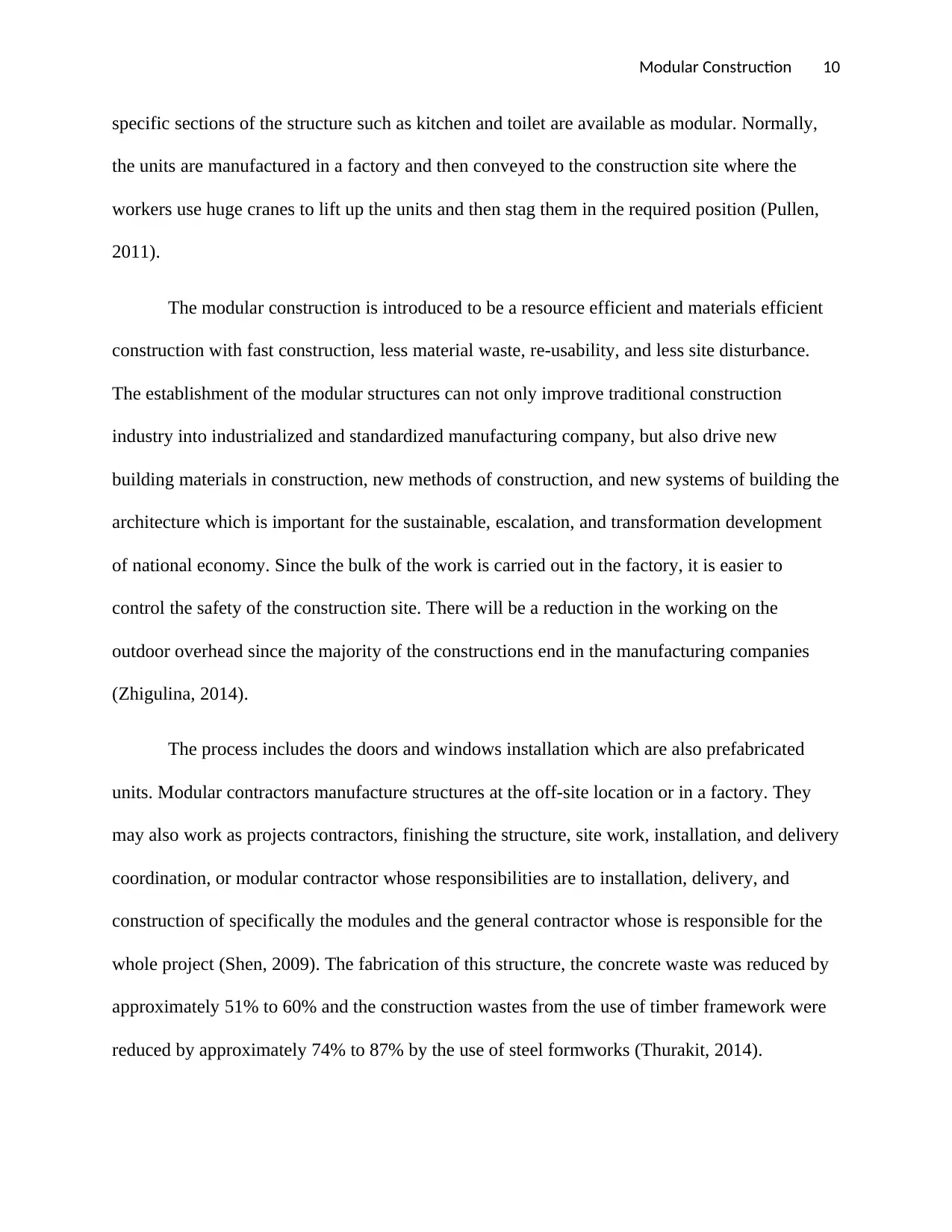
Modular Construction 10
specific sections of the structure such as kitchen and toilet are available as modular. Normally,
the units are manufactured in a factory and then conveyed to the construction site where the
workers use huge cranes to lift up the units and then stag them in the required position (Pullen,
2011).
The modular construction is introduced to be a resource efficient and materials efficient
construction with fast construction, less material waste, re-usability, and less site disturbance.
The establishment of the modular structures can not only improve traditional construction
industry into industrialized and standardized manufacturing company, but also drive new
building materials in construction, new methods of construction, and new systems of building the
architecture which is important for the sustainable, escalation, and transformation development
of national economy. Since the bulk of the work is carried out in the factory, it is easier to
control the safety of the construction site. There will be a reduction in the working on the
outdoor overhead since the majority of the constructions end in the manufacturing companies
(Zhigulina, 2014).
The process includes the doors and windows installation which are also prefabricated
units. Modular contractors manufacture structures at the off-site location or in a factory. They
may also work as projects contractors, finishing the structure, site work, installation, and delivery
coordination, or modular contractor whose responsibilities are to installation, delivery, and
construction of specifically the modules and the general contractor whose is responsible for the
whole project (Shen, 2009). The fabrication of this structure, the concrete waste was reduced by
approximately 51% to 60% and the construction wastes from the use of timber framework were
reduced by approximately 74% to 87% by the use of steel formworks (Thurakit, 2014).
specific sections of the structure such as kitchen and toilet are available as modular. Normally,
the units are manufactured in a factory and then conveyed to the construction site where the
workers use huge cranes to lift up the units and then stag them in the required position (Pullen,
2011).
The modular construction is introduced to be a resource efficient and materials efficient
construction with fast construction, less material waste, re-usability, and less site disturbance.
The establishment of the modular structures can not only improve traditional construction
industry into industrialized and standardized manufacturing company, but also drive new
building materials in construction, new methods of construction, and new systems of building the
architecture which is important for the sustainable, escalation, and transformation development
of national economy. Since the bulk of the work is carried out in the factory, it is easier to
control the safety of the construction site. There will be a reduction in the working on the
outdoor overhead since the majority of the constructions end in the manufacturing companies
(Zhigulina, 2014).
The process includes the doors and windows installation which are also prefabricated
units. Modular contractors manufacture structures at the off-site location or in a factory. They
may also work as projects contractors, finishing the structure, site work, installation, and delivery
coordination, or modular contractor whose responsibilities are to installation, delivery, and
construction of specifically the modules and the general contractor whose is responsible for the
whole project (Shen, 2009). The fabrication of this structure, the concrete waste was reduced by
approximately 51% to 60% and the construction wastes from the use of timber framework were
reduced by approximately 74% to 87% by the use of steel formworks (Thurakit, 2014).
Paraphrase This Document
Need a fresh take? Get an instant paraphrase of this document with our AI Paraphraser
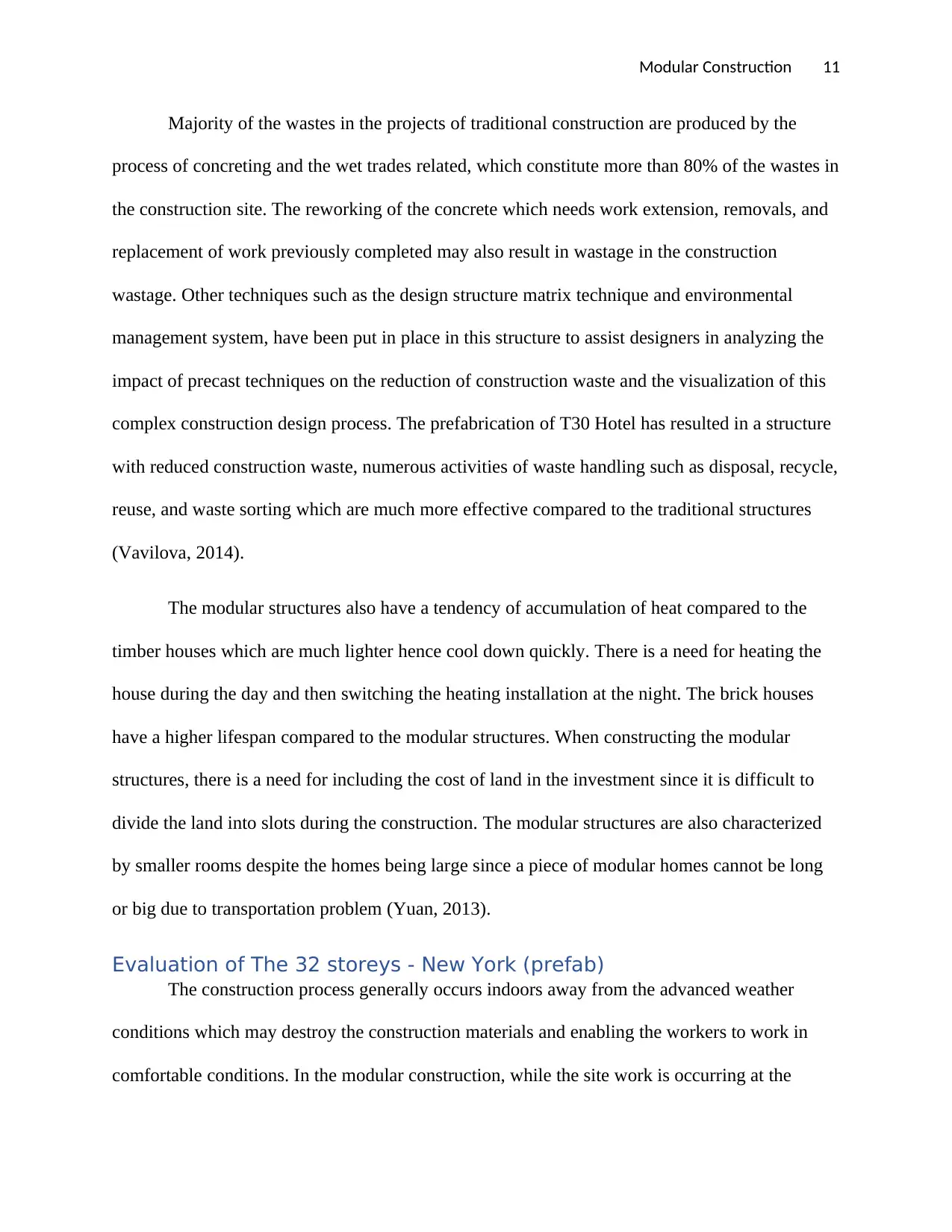
Modular Construction 11
Majority of the wastes in the projects of traditional construction are produced by the
process of concreting and the wet trades related, which constitute more than 80% of the wastes in
the construction site. The reworking of the concrete which needs work extension, removals, and
replacement of work previously completed may also result in wastage in the construction
wastage. Other techniques such as the design structure matrix technique and environmental
management system, have been put in place in this structure to assist designers in analyzing the
impact of precast techniques on the reduction of construction waste and the visualization of this
complex construction design process. The prefabrication of T30 Hotel has resulted in a structure
with reduced construction waste, numerous activities of waste handling such as disposal, recycle,
reuse, and waste sorting which are much more effective compared to the traditional structures
(Vavilova, 2014).
The modular structures also have a tendency of accumulation of heat compared to the
timber houses which are much lighter hence cool down quickly. There is a need for heating the
house during the day and then switching the heating installation at the night. The brick houses
have a higher lifespan compared to the modular structures. When constructing the modular
structures, there is a need for including the cost of land in the investment since it is difficult to
divide the land into slots during the construction. The modular structures are also characterized
by smaller rooms despite the homes being large since a piece of modular homes cannot be long
or big due to transportation problem (Yuan, 2013).
Evaluation of The 32 storeys - New York (prefab)
The construction process generally occurs indoors away from the advanced weather
conditions which may destroy the construction materials and enabling the workers to work in
comfortable conditions. In the modular construction, while the site work is occurring at the
Majority of the wastes in the projects of traditional construction are produced by the
process of concreting and the wet trades related, which constitute more than 80% of the wastes in
the construction site. The reworking of the concrete which needs work extension, removals, and
replacement of work previously completed may also result in wastage in the construction
wastage. Other techniques such as the design structure matrix technique and environmental
management system, have been put in place in this structure to assist designers in analyzing the
impact of precast techniques on the reduction of construction waste and the visualization of this
complex construction design process. The prefabrication of T30 Hotel has resulted in a structure
with reduced construction waste, numerous activities of waste handling such as disposal, recycle,
reuse, and waste sorting which are much more effective compared to the traditional structures
(Vavilova, 2014).
The modular structures also have a tendency of accumulation of heat compared to the
timber houses which are much lighter hence cool down quickly. There is a need for heating the
house during the day and then switching the heating installation at the night. The brick houses
have a higher lifespan compared to the modular structures. When constructing the modular
structures, there is a need for including the cost of land in the investment since it is difficult to
divide the land into slots during the construction. The modular structures are also characterized
by smaller rooms despite the homes being large since a piece of modular homes cannot be long
or big due to transportation problem (Yuan, 2013).
Evaluation of The 32 storeys - New York (prefab)
The construction process generally occurs indoors away from the advanced weather
conditions which may destroy the construction materials and enabling the workers to work in
comfortable conditions. In the modular construction, while the site work is occurring at the
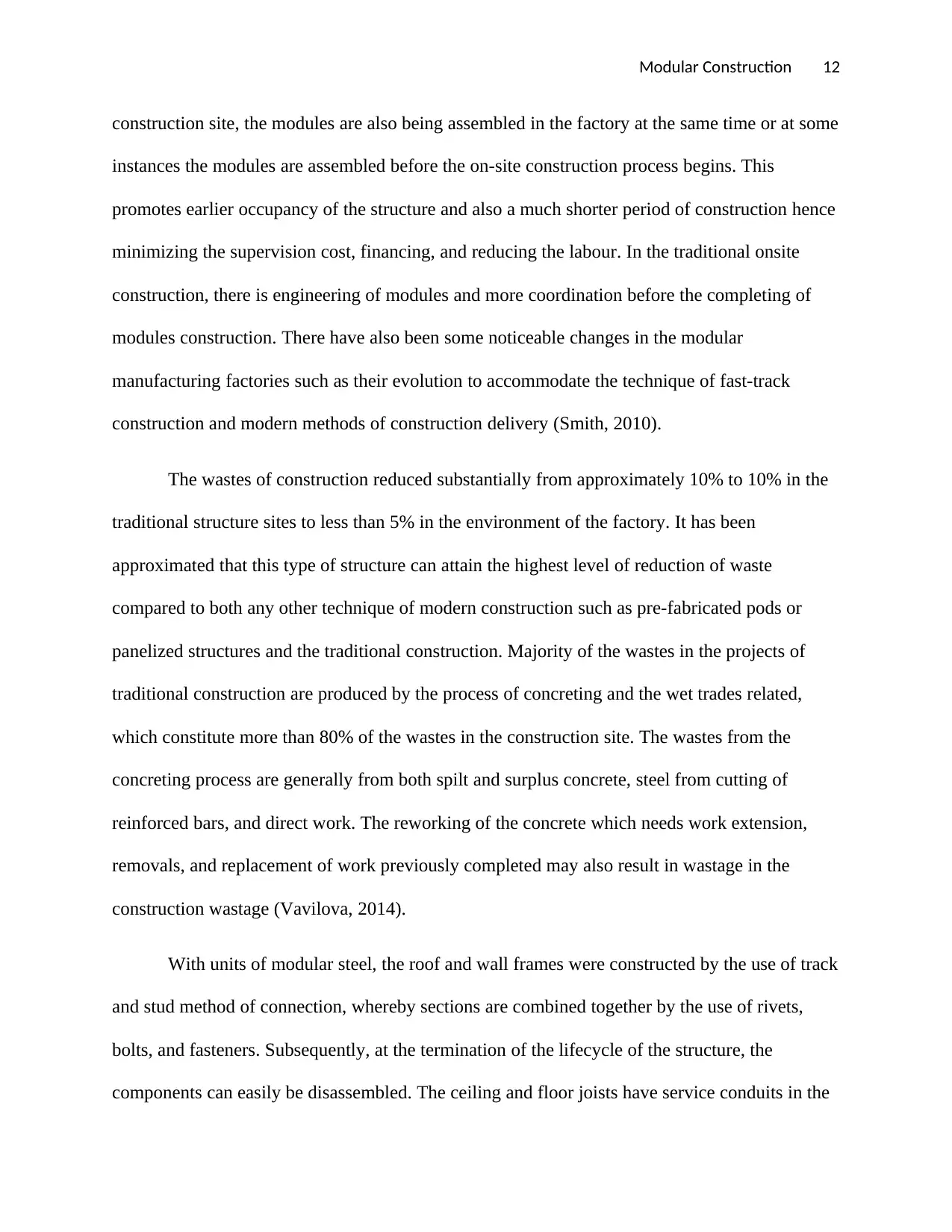
Modular Construction 12
construction site, the modules are also being assembled in the factory at the same time or at some
instances the modules are assembled before the on-site construction process begins. This
promotes earlier occupancy of the structure and also a much shorter period of construction hence
minimizing the supervision cost, financing, and reducing the labour. In the traditional onsite
construction, there is engineering of modules and more coordination before the completing of
modules construction. There have also been some noticeable changes in the modular
manufacturing factories such as their evolution to accommodate the technique of fast-track
construction and modern methods of construction delivery (Smith, 2010).
The wastes of construction reduced substantially from approximately 10% to 10% in the
traditional structure sites to less than 5% in the environment of the factory. It has been
approximated that this type of structure can attain the highest level of reduction of waste
compared to both any other technique of modern construction such as pre-fabricated pods or
panelized structures and the traditional construction. Majority of the wastes in the projects of
traditional construction are produced by the process of concreting and the wet trades related,
which constitute more than 80% of the wastes in the construction site. The wastes from the
concreting process are generally from both spilt and surplus concrete, steel from cutting of
reinforced bars, and direct work. The reworking of the concrete which needs work extension,
removals, and replacement of work previously completed may also result in wastage in the
construction wastage (Vavilova, 2014).
With units of modular steel, the roof and wall frames were constructed by the use of track
and stud method of connection, whereby sections are combined together by the use of rivets,
bolts, and fasteners. Subsequently, at the termination of the lifecycle of the structure, the
components can easily be disassembled. The ceiling and floor joists have service conduits in the
construction site, the modules are also being assembled in the factory at the same time or at some
instances the modules are assembled before the on-site construction process begins. This
promotes earlier occupancy of the structure and also a much shorter period of construction hence
minimizing the supervision cost, financing, and reducing the labour. In the traditional onsite
construction, there is engineering of modules and more coordination before the completing of
modules construction. There have also been some noticeable changes in the modular
manufacturing factories such as their evolution to accommodate the technique of fast-track
construction and modern methods of construction delivery (Smith, 2010).
The wastes of construction reduced substantially from approximately 10% to 10% in the
traditional structure sites to less than 5% in the environment of the factory. It has been
approximated that this type of structure can attain the highest level of reduction of waste
compared to both any other technique of modern construction such as pre-fabricated pods or
panelized structures and the traditional construction. Majority of the wastes in the projects of
traditional construction are produced by the process of concreting and the wet trades related,
which constitute more than 80% of the wastes in the construction site. The wastes from the
concreting process are generally from both spilt and surplus concrete, steel from cutting of
reinforced bars, and direct work. The reworking of the concrete which needs work extension,
removals, and replacement of work previously completed may also result in wastage in the
construction wastage (Vavilova, 2014).
With units of modular steel, the roof and wall frames were constructed by the use of track
and stud method of connection, whereby sections are combined together by the use of rivets,
bolts, and fasteners. Subsequently, at the termination of the lifecycle of the structure, the
components can easily be disassembled. The ceiling and floor joists have service conduits in the
⊘ This is a preview!⊘
Do you want full access?
Subscribe today to unlock all pages.

Trusted by 1+ million students worldwide
1 out of 19
Related Documents
Your All-in-One AI-Powered Toolkit for Academic Success.
+13062052269
info@desklib.com
Available 24*7 on WhatsApp / Email
![[object Object]](/_next/static/media/star-bottom.7253800d.svg)
Unlock your academic potential
Copyright © 2020–2025 A2Z Services. All Rights Reserved. Developed and managed by ZUCOL.





